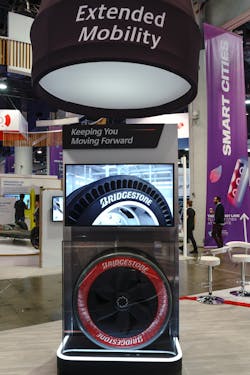MTD Exclusive: An Up-Close Look at Bridgestone's "Air-Free" Tire
Bridgestone Corp. showcased its latest concept – an airless, or what it calls an “air-free” tire – during the 2020 Consumer Electronics Show (CES) in Las Vegas. Nev.
The concept’s design “eliminates the need for tires to be filled and maintained with air, and essentially erases the dangers and downtime associated with a flat tire,” say Bridgestone officials. MTD recently caught up with Jon Kimpel, executive director, new mobility solution engineering, Bridgestone Americas Inc., who provided additional details about the company’s air-free concept, including possible commercial applications.
MTD: How long has Bridgestone’s air-free tire been in development? Can you tell us more about the design and the purpose of the concept?
Kimpel: Bridgestone, overall, has been working on air-free tires for 10-plus years in a lot of different applications. The one that’s closest to a market standpoint is for a bicycle application. It actually will be used in Olympic Village in Tokyo (this year.) The construction is really based on a wheel design, and then a web and then the tread.
MTD: The design of the air-free concept appears to be less complex than a standard tire. Is that true?
Kimpel: I don’t know if I would go that far, from a complexity standpoint. It doesn’t have a bead as you would have on a conventional pneumatic tire, but in terms of reinforcement technology, etc., there is a tremendous amount that goes into it. It is much less complex from a maintenance standpoint because you remove that variable of air. But there’s a lot that goes into the material in the web, the reinforcements in the actual tread, etc. That’s where the design complexity comes in.
MTD: Can you discuss the reinforcements and other components at a greater level of detail? What gives the tire its strength, durability and load-carrying capacity and how might that compare to a passenger tire?
Kimpel: One of the tires we (displayed) at CES is for tractor-trailer applications, which is one of the most demanding applications you can choose. A pneumatic tire for a tractor-trailer has a psi level of 120 and that air does a tremendous amount of work. In terms of the actual construction, (the air-free concept tire) has a wheel in the center part that’s similar to a rim you have today – with the exception that there is no bead on the tire. It’s truly been the advancements of engineering and material science that have accelerated (the concept’s development) over the last two to three years. One of the big things we had to get over, from a technical standpoint, is how you handle the bead.
MTD: When do you plan to industrialize and mass-produce the concept? Is there a timeline?
Kimpel: Bridgestone is exploring a number of air-free tire concepts for various applications. The company has developed a bicycle with air-free tires. These bicycles will be used in a limited capacity this summer at the Olympic and Paralympic Games Tokyo 2020 to help support staff, volunteers and athletes move across the athlete village.
Beyond that, air-free tires in the tractor-trailer application, as an example, that’s more years away. The concept is still in the validation phase. As a consumer, if I have low tire pressure, that’s a safety concern and an inconvenience. For a (trucking) fleet, there’s a huge financial impact. That’s where we see trying to accelerate commercialization.
MTD: You’re targeting the medium truck tire segment. Do you see future applications on traditional consumer vehicles?
Kimpel: The strategy we have is to go after that long-haul (application), where maybe tires aren’t always maintained as they should be from an air pressure standpoint. From there, you can go into other areas. You can start thinking about autonomous vehicles, where there is no driver to do the maintenance of the tire.
MTD: Do you foresee this product being sold through Bridgestone's dealer network?
Kimpel: Our dealers are very important in terms of taking care of our customers. On the service side – but also in terms of showing (consumers) the value of (our tires) – we really depend on our dealer network.
From a commercial standpoint, “what’s also a big part of this is how we handle retreading,” Kimple told MTD. “These tires are intended to be retreaded.”
